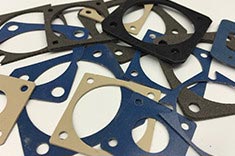EMI Shielding Products
- Custom Gasket Fabrication
- Connector Gaskets
- Bonded O Ring
- Custom Gaskets
- Conduct-O-Knit Knitted Wire Mesh
- Conduct-O-Seal Combo Gasket
- Conduct-O-Elastomer
- Conduct-O-Seal Oriented Wire in Silicone Gasket Material
- Conduct-O-Mesh Tape
- Conduct-O-Foam
- Conduct-O-Bond
- Optical Filters For Electronic Displays
- Shielded Vent Panels
- ESC Board Level Shielding
- 300 Series
How to Make EMI Shielding Gaskets
 The prototyping phase in EMI (Electromagnetic Interference) gasket manufacturing is a critical juncture that bridges conceptual design and mass production. Its importance can be distilled into four key aspects: validation of design and functionality, identification and resolution of issues, cost-effective design refinement, and ensuring compliance with standards.
The prototyping phase in EMI (Electromagnetic Interference) gasket manufacturing is a critical juncture that bridges conceptual design and mass production. Its importance can be distilled into four key aspects: validation of design and functionality, identification and resolution of issues, cost-effective design refinement, and ensuring compliance with standards.
The Importance of EMI Gasket Prototyping
- Validation of Design and Functionality - In the world of electronic devices, where precision is paramount, the functionality of an EMI gasket is non-negotiable. For instance, consider a gasket designed for a high-sensitivity medical device like an MRI scanner. Prototyping provides a tangible version of the gasket, allowing engineers to test and confirm that it effectively blocks electromagnetic noise, which could otherwise distort diagnostic images. This stage is crucial to ensure the device's reliability in sensitive medical diagnostics.
- Identification and Resolution of Issues - Real-world testing during prototyping can unearth hidden flaws. For example, a prototype gasket used in aerospace might be exposed to extreme temperature variations, revealing issues like material degradation or loss of elasticity, which simulations might not predict. Addressing such issues in the prototyping phase is vital to ensure the gasket's durability and effectiveness in protecting sensitive onboard electronics in aircraft.
- Cost-Effective Design Refinement - Iterative design refinements during prototyping are more economical than modifications during full-scale production. Take, for instance, a gasket for consumer electronics like smartphones. Minor adjustments in material composition or thickness during prototyping can significantly enhance performance without incurring the high costs associated with altering production lines later.
- Ensuring Compliance with Standards - EMI gaskets must often adhere to stringent industry standards. While prototyping a gasket for automotive electronic systems, compliance with standards like ISO 11452-2 for electromagnetic compatibility testing is critical. Prototyping allows manufacturers to test and ensure that their product meets these standards, thereby avoiding costly recalls or compliance issues after launching the product.
The prototyping phase in EMI gasket manufacturing is more than just a preparatory step; it's a comprehensive process that ensures functionality, identifies and resolves potential issues, optimizes cost, and ensures compliance with industry standards. By investing adequate resources and attention during this phase, manufacturers can avoid costly mistakes, enhance product quality, and ensure adherence to essential standards, ultimately leading to a successful and reliable final product.
Steps of EMI Gasket Prototyping
- Conceptual Design: Define the requirements for the EMI gasket based on its intended application. Draft initial design specifications, including dimensions, materials, and expected performance characteristics.
- Material Selection: Choose appropriate materials that provide the necessary EMI shielding properties. Options can include conductive silicones, metals, or fabric-over-foam materials.
- Initial Prototype Creation: Develop a prototype based on the initial design using rapid prototyping techniques like 3D printing, CNC machining, or hand fabrication.
- Laboratory Testing: Conduct laboratory tests on the prototype to measure its effectiveness in shielding against electromagnetic interference. Assess physical properties like durability, flexibility, and resistance to environmental factors.
- Analysis and Feedback: Analyze test results to determine if the prototype meets the design specifications and performance requirements. Gather feedback from engineers and other stakeholders.
- Design Refinement: Modify the design based on test results and feedback. Adjust materials, dimensions, or other features to enhance performance or resolve identified issues.
- Iterative Prototyping: Repeat the cycle of creating revised prototypes, testing, and refining the design based on ongoing analysis and feedback until the desired performance is achieved.
- Compliance Testing: Conduct tests to ensure the final prototype meets relevant industry standards and regulatory requirements for EMI shielding.
- Field Testing: Test the prototype in real-world conditions similar to its intended use case, such as electronic devices, automotive systems, or aerospace applications.
- Final Design Approval: Obtain final prototype design approval from all stakeholders, including compliance and engineering teams.
- Preparation for Mass Production: Transition the approved prototype design into a production-ready format. Set up manufacturing processes, tooling, and quality control measures for mass production.
By following these steps, the prototyping process ensures that the EMI gasket meets the desired technical specifications and performs effectively in its real-world application.
EMI Shielding Gasket Protocols with East Coast Shielding
Partner with East Coast Shielding for all your EMI- and RFI-related needs. We can help you customize EMI shielding gaskets based on your needs. For more information, you should not hesitate to call our talented team.



